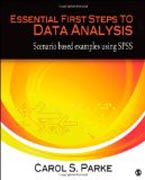
//> The purpose of this book is to provide instruction and guidance on preparing quantitative data sets prior to answering a studyÆs research questions. Preparation may involve data management and manipulation tasks, data organization, structural changes to data files, or conducting preliminary analysis such as examining the scale of a variable, the validity of assumptions or the nature and extent of missing data. The ôresultsö from these essential first steps can also help guide a researcher in selecting the most appropriate statistical tests for his/her study. The book is intended to serve as a supplemental text in statistics or research courses offered in graduate programs in education, counseling, school psychology, behavioral sciences, and social sciences as well as undergraduate programs that contain a heavy emphasis on statistics. The content and issues covered are also beneficial for faculty and researchers who are knowledgeable about research design and able to use a statistical software package, but are unsure of the first steps to take with their data. Increasingly, faculty are forming partnerships with schools, clinics, and other institutions to help them analyze data in their extensive databases. This book can serve as a reference for helping them get existing data files in an appropriate form to run statistical analysis. This book is not a replacement for a statistics textbook. It assumes that readers have some knowledge of basic statistical concepts and use of statistical software, or that they will be learning these concepts and skills concurrently throughout the course. SPSS was chosen to illustrate the preparation, evaluation, and manipulation of data. However, students or researchers who do not use SPSS will benefit from the content since the overall structure and pedagogical approach of the book focuses heavily on the data issues and decisions to be made. INDICE: Section 1. The SampleModule 1. Checking the Representativeness of a SampleModule 2. Splitting a File, Selecting Cases, Creating Standardized Values and RanksSection 2. Nature and Distribution of VariablesModule 3. Recoding, Counting, and Computing VariablesModule 4. Determining the Scale of a VariableModule 5. Identifying and Addressing OutliersSection 3. Model AssumptionsModule 6. Evaluating Model Assumptions for Testing Mean DifferencesModule 7. Evaluating Model Assumptions for Multiple Regression AnalysisSection 4. Missing DataModule 8. Determining the Quantity and Nature of Missing DataModule 9. Quantifying Missing Data and Diagnosing its PatternsSection 5. Working with Multiple Data FilesModule 10. Merging FilesModule 11. Aggregating Data and Restructuring FilesModule 12. Identifying a Cohort of Students
- ISBN: 978-1-4129-9751-5
- Editorial: SAGE Publications, Inc
- Encuadernacion: Rústica
- Páginas: 288
- Fecha Publicación: 05/02/2013
- Nº Volúmenes: 1
- Idioma:
